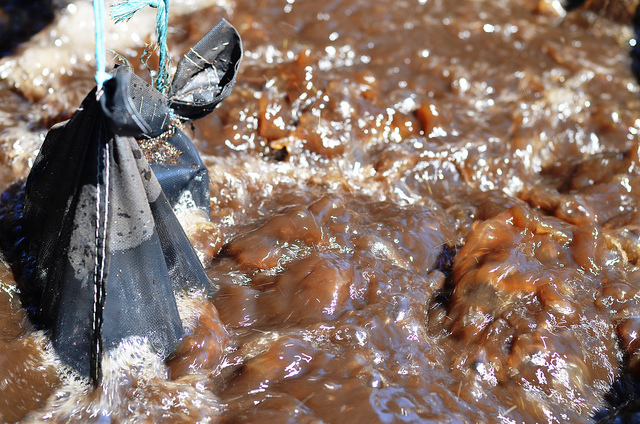Aerated Compost Tea Brewer
This page is a work in progress.
Design Rationale
The purpose of an Aerated Compost Tea Brewer is to take raw, organically-based feedstocks and use them as feedstocks of bacteria and fungi that are beneficial and even protective to plants in order to increase their productivity, ensure they do not harbor bacteria that are harmful to them or to people ingesting them. Additionally, it shortens the amount of time to convert waste into plant-ready fertilizer. This will need to be a series of designs meant to scale functionality, but not design. For example, it is not practical to use 50+ 5 gallon buckets when an Intermediate Bulk Container can be used.
Function
A compost tea brewer immerses biological matter in water that is highly aerated. The purpose of aerating it is to ensure that "good" bacteria and fungi, which for the most part thrive in aerobic environments ("bad" bacteria thrive in aenerobic environments generally) out-compete bad bacteria and fungi. These good bacteria help plants fix nitrogen, absorb nutrients, and release antibiotics that kill bad bacteria and fungi. There are many recipes for compost tea, but most have the following inputs:
Inputs
- Molasses: provides a source of sugars to help cultivate the microbes that decompose the biological wastes into plant-available forms.
- Mycorrhizae: Helps plants absorb nutrients, provides a physical barrier to prevent root rot, releases antibiotics that kill bad bacteria.
- Azotobacter: These bacteria fix nitrogen to make it available to plants.
- Fibrous and vegetative biomass: this gives a balance of starches for the culture and sources of nitrogen to be made bioavailable. Generally, 50-70% fiber, 50-30% vegetative.
- Rock dust: provides trace nutrients
- Fish and animal feces
- Grey water
- Worm castings: worm castings are a good starter of the culture, plus are loaded with nutrients.
Outputs
Compost tea- It's a growth media, foliar spray, and an innoculant. Studies have shown that a foliar spraying with compost tea at the right time can massively increase yields significantly (citation soon)
Materials
- CEB Water Cistern
- Stainless Steel Mesh Box
- Oiless compressor- used for various other applications in the holistic aquaponics greenhouse toolkit
- Pressure regulators
- Airstones
- 5 micron filter
- Azomite[1]
- Biofertilizer [2] starter culture
- Various ABS plumbing fixtures
Design Documentation
Iteration 1: Parts: 1. 5 gallon bucket 2. Bulkhead mounted pvc spigot 3. 4 outlet air pump was used with two alumina cylinder airstones, and two aerators that mount to the side of the bucket. 4. 5 gallon bucket paint strainer Tools needed: 1 1/2" hole saw and a drill.
Construction: Drill a 1 1/2" hole in the side of the bucket near the bottom. Plumb in the bulkhead spigot. Cut 4 pieces of poly air tubing; make sure to cut them long enough for them two of them to reach the bottom of the bucket, and the other two have enough slack to be able to reach the middle of the water column. Drill 4 holes in the lid wide enough for the tubing to fit through. you will want two of these holes to be on the edge of the lid, one on one side and one on the other. The other two can be in the middle. Mount the two straw-like aerators to the side of the bucket towards the bottom. Next, place the 5 gallon paint strainer bag in the bucket, ensuring the elastic band fits around the top of the bucket. Attach the two sintered alumina cylindrical airstones to the two poly air tubing in the center, and place them in the paint strainer bag. Attach all 4 poly air tubes to the aquarium pump.
Usage instructions: Fill the bucket 2/3 full with water. If the water is from the water supply, bubble it with the airstones for a couple of hours. Fill the paint strainer bag with about 1 pound of partially decomposed compost that was mixed with a proper 60/40% ratio of greens and brown biomass. For a bacterially balanced tea, add a small handful of finish compost. For a fungal balance tea, add some soil from within a heavily wooded area that has not been disturbed for a long period of time. Place 2 tablespoons of unsulfured molasses in the water as well. Optionally, Azomite provides abundant trace minerals. (More here later)
